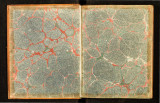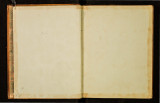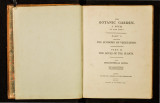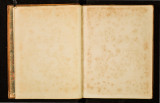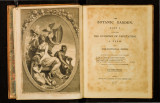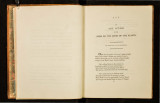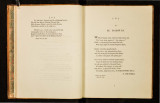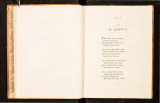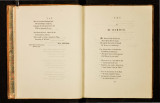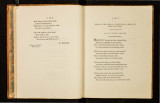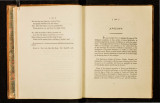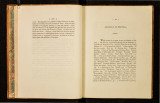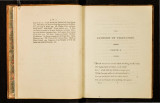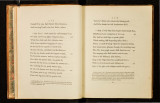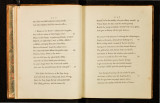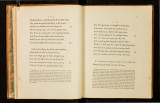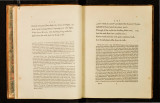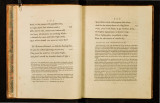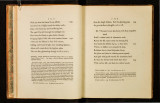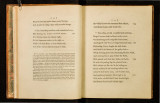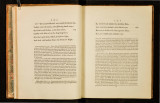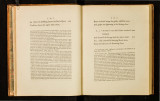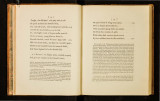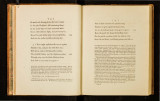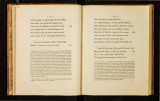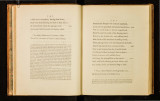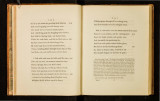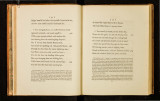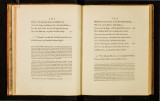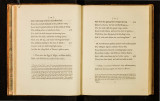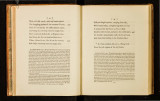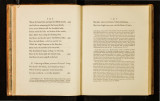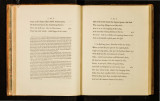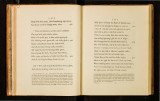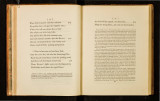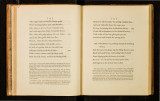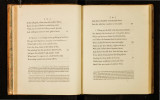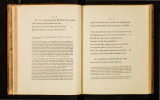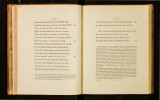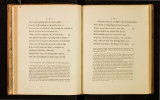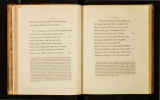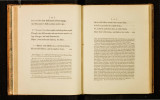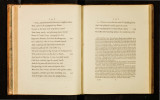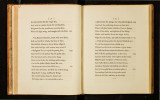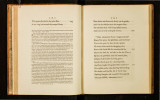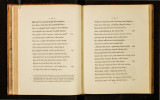| OCR Text |
Show WINDS. NoTE XXXIII. portant quelnl'w n pre {ie n t s 1· 1 ~e ]f here ' 1ijthc climate to which .J his Jou. th-wo/1 w. ind .a rrivhe s, is not coMer than that it comes from, wby .fhould it dcpoJit. tis moifiurc durrng r!s w o:t journey? if it be a colder climate, why does it c_om_c thtther? The to:nadoes of a1r ·a bo ve d e1r cn' b ed can ex te 11d but a little \vay ' and tt JS not eafy to concetve that a fu- pen·o r co• ld current o f a1·1. can mix. with an inferior one, and. thus produce fhowers over ten degrees of country, finee at about three miles high there IS perpetual frofl:; and what can induce thefe narrow and Jhallow currents to flow over each other fo many hundred miles? Though the earth at the northern extremit~ of this_ monfoon may be more ~eated by certain circumflances of fituation than at the l111e, yet 1t fc.:ems probable tl~at the J~termcu_,. J atecountry b etw e en that •a nd the line ' may continue cold.e r than the lme .( as m other parts of the earth) and hence that the air coming from the lme_ to fupply th1s afcent or defl:ru8.ion of air at the northern extremity of the monfoon wtll be cooled all the way 1· n J· ts approac h , and in confcquencc depout its water. It feems p. robable . that at the northern extremity of this monfoon, where the tornadoes or hu~nc~ne~ ~xtft, _that the air not only a[cends but is in part converted into water, o.r otherwtfe dun~m01ed m quan-tity, as no account is given of the exiftence of any .fupen~r currents of It. . As the fouth-wefl: winds are always attended wtth a hght atmofphere, an mclptcnt vacancy or a great diminution of air muft have taken place_ to the n~rthw~rd of them in all parts of the earth wherever they exifl, and a depofitwn of thetr mmflurc fuccecds their being cooled by the climate they arrive at, and not by a contrary current ~f cold air over them, fince in that cafe the barometer would not fink. They may thus 111 our own country be termed monfoons without very regular periods. 3· Another caufe of ToRNADOES independent of the monfoons is ingenioufly explained by Dr. Franklin, when in the tropical countries a firatum of inferior air becomes [o heated by its contact with the warm earth, that its expanfion is increafed more than is equivalent to the preflure of the fl:ratum of air over it; or when the fuperior Hratum becomes more condenfcrl by cold than the inferior one by prefiure, the upper region will defcend and the lower one afcend. In this Gtuation if one part of the atmofphere be hotter from fome fortuitous circumftances, or, has lefs preffure over it, the lower firatum will begin to afcend at this part, and refemble water falling through a hole as mentioned above. If the lower region of air was going forwards with confiderable velocity, it will gain an eddy by rifing up this hole in the incumbent heavy air, fo that the whirlpool or tornado has not only its progreffive velocity, but its circular one alfo, which thus lifts up or overturns every thing within its fpiral whirl. By the weaker whirlwinds in this country the trees are fometimes thrown down in a line of only twenty or forty yards in breahh, making a kind of avenue through a country. In the Weft Indies the fea riCes like a cone in the whirl, and is met by black clouds produced by the cold upper air :md the warm lower air being rapidly mixed; whence are produced the great and fudden rains called water-fpouts ; while the upper and lower airs exchange their plus or minYs elettri<;ity in pcrpetuallightenings. NoTE XXXIII. WINDs. LA~D AND EA-llREEZES. The fea being a tranfp::trcnt m:tls i lefs h .1 • • eatC<I at Its furface by the ii • the land, and its continual chano-eof furfac .b un s rays than . . "' e contn Utt:s to preferve a g t .f. . ll1 the heat of the atr which han<rs over it H 1 ~rea er unt ormJty . o · ence t 1e furface of the trop' . I ·n d . more heated dunng the day than the fea th t r d h JC,l I an sIS . . , a wrroun s t em, and co I . n~ght by rts greater clev:ltion: whence in the aft . h 1 ° s more 111 the ' et noon w en t re lands of th . I ifl:mds have been mtrch heated by the fun the a· h r c troptca . ~ . ' lr over t em aJcends prdfc d d by the cool er arr ot the tncirclino- ocean in the . . · e upwar s . "' ' mornmg ag:Hn the land beco . I cd more than the fea, th arr over it defccnds b . t . G d . mmgcoo - the ocean near its fhores . y 1 s lllCrea e gravity, and blows over C 0 ~ C L U S r 0 N. 1. l here arc varion~ irregular winds belid~.:s thofc, b d fi .b . l .· 1 . . . . . e a ove e en cd, whrch confift of JO JJZo!1ta or ve1 t1cal edcltes of arr ow1n" to the· 1· f . . f' . f . - . o rnequa Jty o the earth's furface, or the J' rxtap-o ruon o the Ita. Or her rrregular winds ha. h · · · · . . . \ e I err ongrn from I ncreafed eva ora twn of water, or liS fudJen dcvaporation «nrl defccnt · {1 . p - r. . 111 lOWers, others from the partial c. panuon :md condenfatJOn of air by heat anu cold. b h . I" n .· t1 . . ' . ' y t e accumulJtJOn or defect of e -CLI JC urd, or to the a1r s new produclton or abf< · · fi . orpt!On occa roned by local caufe not yet drfco\ered. Sec Notes VII. and XXV. s 2.. Th rc fcem to eAi'fl: only two original vinds: one confiftine: of a· b 1 1 . I l d I "' 1r roug Jt rom t 1e nort r, an t 1e other of air brought from the fouth Tl r f 1 r · . . · le wrmer o t 1e1e wwds has alfo gcnerall y an apparent d1reflJOn from the caft and 1 he latter from th. f1 .fi f 1 1· ffi · · ' e we , an rng rom t 1e c_t l!rent velocities of the earth's furfacc . All the other winds above defcribcd arc ddieClrons or rctrogrc!Tions of fon1e parts of thcfe ciments of air fro th 1 fouth. m e norlol or . 3· ?ne fifteenth part oft he at~ofphere is occafionally dc.:ftroyed, and occaftonally rep! odul:ed by unkn,nvn caufes. fhcf~.: caufes are brought into immediate a8.ivity over a great part of the fur face of the earth at nearly the f.·une time, but always more powerful to the northward than to the fouthward of any given place; and would hence feem to have their principal cffe8: in the polar circles, exifting neverthelefs though with Jefs power toward the tropics or at the line. For when the north-eaft wind blows the b:uometer riles, fometim~s from 28} inches to 30h which fhe>l'5 a great new generation of air in the north; and when th-e fouthweft wind blows the barometer finks as mnch, which fh ews a gre<1t deftrutlion of air in the north. l3ut as the north-ean winds fometimes continue for five or fix weeks, the newly-generated air mufl: be del1roycd :~t thofe times in the warmer clim1te · to th·~ [outh of us, or circ11bte in fuperior currems, which }us been !hewn to be irnprob:tblc from its not depofiting its water. And as the fouth-wcn winds fomctimes continue for fomc weeks, I here rnuH be a generation of air to the fouth at thofe times, or fuperior currents, \\ hich bft has bel:!n 01ewn to be improbable. 4· The north-eaft winds being generated about the poles are pufhed forwards towards the tropics or line, by the preffure from behind, and hence they become wanner, as M |



